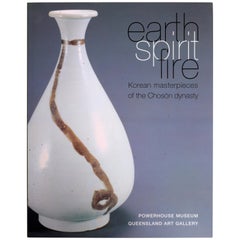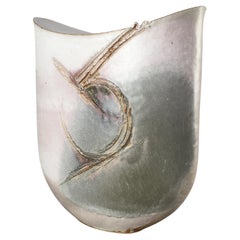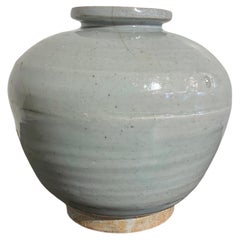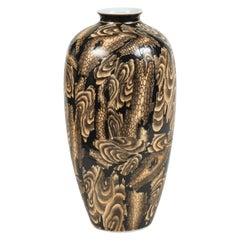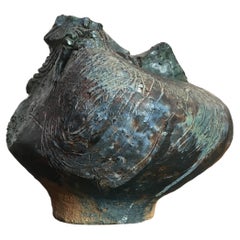Australian Ceramics
1
1
to
1
2
2
2
1
1
1
1
1
1
1
2,841
4,356
3,794
2,043
1,647
1
Place of Origin: Australian
Earth, Spirit, Fire: Korean Masterpieces, Choson Dynasty ‘1392-1910’
Located in valatie, NY
Earth, Spirit, Fire: Korean Masterpieces of the Choson Dynasty (1392-1910) by Claire Roberts and Michael Brand. First edition softcover. Powerhouse Muse...
Category
Early 2000s Australian Ceramics
Materials
Paper
Monumental Signed Shunichi Inoue White and Rose Ash Glazed Vase 1978
By Shunichi Inoue
Located in Melbourne, AU
A wonderful example of the work of master Japanese potter, Shunichi Inoue. This vessel dates from his Australian residency.
We love the potency of this very simple form - it has a powerful presence, connoting stillness, composure. For some reason it makes me think of the moon. It has the same still, calm, abiding presence.
Shunichi Inoue studied ceramics at Kyoto City University of Arts 1969-75. He travelled to Australia to lecturer in ceramics at the Bendigo College of Advanced Education in Victoria, Australia where he stayed for three years.
He returned to Australia in late 1984 as a visiting professor and again in 1993, when he made an extended stay.
He was an active exhibitor and had an important influence on Australian pottery...
Category
1970s Organic Modern Vintage Australian Ceramics
Materials
Earthenware
Related Items
Korean White Glazed Jar, Joseon Dynasty, 18th Century, Korea
Located in Austin, TX
A sublime Korean white glazed porcelain globular jar, Joseon Dynasty, 18th century, Korea.
The squat jar is heavily potted, with a globular body, very short neck, and wide mouth r...
Category
18th Century Antique Australian Ceramics
Materials
Porcelain
Japanese Glazed Ceramic Vase
Located in Palm Desert, CA
Very unique tall Japanese vase with abstract pattern in a variety of brown tones. The deepest brown glaze is raised, giving the vase a wonderful tac...
Category
Late 20th Century Organic Modern Australian Ceramics
Materials
Ceramic
Korean Celadon Inlay Vase Goryeo Dynasty
Located in Atlanta, GA
On offer is an antique Korean ceramic vase from the end of Goryeo to the beginning of Joseon period (circa 14-15th). The vase features celadon crackled glaze with underglaze inlay design in black and white. The vase was a transitional piece made toward the end of Goryeo to the beginning of Joseon Yi dynasty...
Category
15th Century and Earlier Archaistic Antique Australian Ceramics
Materials
Ceramic
Blue and White Chinese Lidded Ginger Jar, Vase or Urn, Signed on Bottom
Located in Stamford, CT
Blue and white Chinese lidded ginger jar. Large and Impressive. Signed on bottom is this very impressive lidded jar from China having a long heavy bottom and a lid with a handle. 19t...
Category
Mid-20th Century Chinese Export Australian Ceramics
Materials
Porcelain
Two Korean White Ceramic Jars Joseon Dynasty
Located in Atlanta, GA
Two ensuite Korean porcelain jars circa early 19th century Joseon Dynasty, attributed to Punwon-ri ware and measures 5.5" diameter x 4" height and...
Category
Early 19th Century Archaistic Antique Australian Ceramics
Materials
Ceramic
Korean White Glazed Porcelain Bottle Vase, Joseon Dynasty, 19th Century, Korea
Located in Austin, TX
A subtle and elegant Korean Joseon Dynasty white glazed porcelain bottle vase, 19th century, Korea.
The bottle vase with an unusual globular body, nar...
Category
19th Century Antique Australian Ceramics
Materials
Porcelain
Shoji Hamada Tenmoku Glaze and Kaki Trailing Vase and Original Signed Sealed Box
By Shoji Hamada
Located in Studio City, CA
An exquisite, beautifully crafted Japanese pottery vase by master potter Shoji Hamada featuring Hamada's famous signature tenmoku glaze with kaki trailing. The original Hamada signed and sealed wood storage box is included as well as the written appraised signature of his son Shinsaku Hamada. The vase also comes with a printed artist profile/sales brochure of Hamada (featuring some of his other presumably available work). It appears this piece was offered at the Keio Department store in Shinjuku, Tokyo. At first glance, this may seem odd but in fact, this is quite an honor in Japan. This store is known for selling and exhibiting such high-profile artists and potters as Bernard Leach, Lucie Rie, Gyokudo Kawai, Shiko Munakata, Kawai Kanjiro, and Rosanjin Kitaoji. A major goal of many ceramic artists in Japan is to have a one-man exhibition in a department store. For many Westerners, this is a strange concept. Some of the larger department stores have up to three or four dedicated galleries showing concurrent art exhibitions. A well-known artist's exhibition can bring in hundreds, often thousands, of customers to a store and increase revenue for other sales in the millions-of-yen range. These exhibits are usually longer running and highlight a potter's career, like a Living National...
Category
Mid-20th Century Showa Australian Ceramics
Materials
Stoneware
H 10 in W 4.75 in D 4.75 in
White Porcelain Moon Jar, Joseon Dynasty / 1392-1897
Located in Kyoto-shi, Kyoto
This is a white porcelain jar from the mid-Joseon period, also known as a "Talhunari" or "moon jar". During the Joseon Dynasty, which was strongly influenced by Confucianism, the purity of white porcelain was particularly prized in its artistic expression due to its Confucian sensitivity. The defining characteristic of white porcelain during this period was its pure white color, but there were many subtle variations in the white hues, with some being classified as milky white, snowy white, ashen white, and bluish white.
The term "Talhunari" means "moon jar" in Korean, and it refers to the large, round shape of the jar, resembling a full moon. It was named by Kim Whanki, a representative abstract painter of Korea. The soft, curving lines and sturdy body that seems to embrace the full moon give the jar both power and tranquility. This type of jar was produced in large quantities during the 17th century.
The white of the moon jar is not the pure white of early Joseon porcelain...
Category
18th Century Antique Australian Ceramics
Materials
Ceramic, Porcelain
Shoji Hamada Japanese Earth-Toned Glazed Vase with Original Signed Sealed Box
By Shoji Hamada
Located in Studio City, CA
An exquisite, beautiful flower vase by master Japanese potter Shoji Hamada featuring an example of his popular two-color, sumptuous earth-toned ...
Category
Early 20th Century Showa Australian Ceramics
Materials
Stoneware
H 7.8 in W 4 in D 3.5 in
Celadon Ceramic Tea Bowl Korean Goryeo Dynasty
Located in Atlanta, GA
An antique Korean ceramic tea bowl with celadon glaze from Goryeo dynasty, circa 12th century. The thin-walled stoneware bowl was potted delicately with...
Category
15th Century and Earlier Archaistic Antique Australian Ceramics
Materials
Ceramic
Korean Silla Dynasty Footed Jar, circa 6th Century, Korea
Located in Austin, TX
A charming Korean high fired gray pottery stoneware footed vessel, Three Kingdoms Period, Silla Kingdom, circa 6th century.
The vessel of traditiona...
Category
15th Century and Earlier Antique Australian Ceramics
Materials
Pottery, Stoneware
Monumental Pair of Antique Chinese Qing Dynasty Famille Rose Porcelain Vases
Located in Portland, OR
Monumental pair of antique Chinese late Qing to early Republican period Famille Rose Porcelain vases. The vases of baluster form with appli...
Category
Early 20th Century Qing Australian Ceramics
Materials
Porcelain
Previously Available Items
1960s Brutalist Sgraffito Earthenware Mingei Bizen Ikebana Vase Green Grey Black
Located in Melbourne, AU
A most impressive Brutalist Ikebana vase dating to the 1960s, made in Australia. The vase comes from a major collection of Japanese and Australian Ikebana vases. Unsigned.
Our fa...
Category
1960s Brutalist Vintage Australian Ceramics
Materials
Earthenware
H 6.89 in W 6.7 in D 5.91 in
Recently Viewed
View AllMore Ways To Browse
Chinese Ruyi
Pair Blue Asian Vases
Japanese Kutani Porcelain
Japanese Tea Sign
Chinese Porcelain Iron
White Asian Pottery
South East Asian Art
Japanese Export Porcelain
Canton Rose
Asian Foo Dogs
Asian Furniture Foo Dogs
Rose Canton
Japanese Blue And White Ceramic
Antique Chinese Rose Medallion Porcelain
Asian Antique Blue And White Vases
Qing Famille Rose
17th Century Edo Period
18th Century Chinese Qianlong Porcelain
